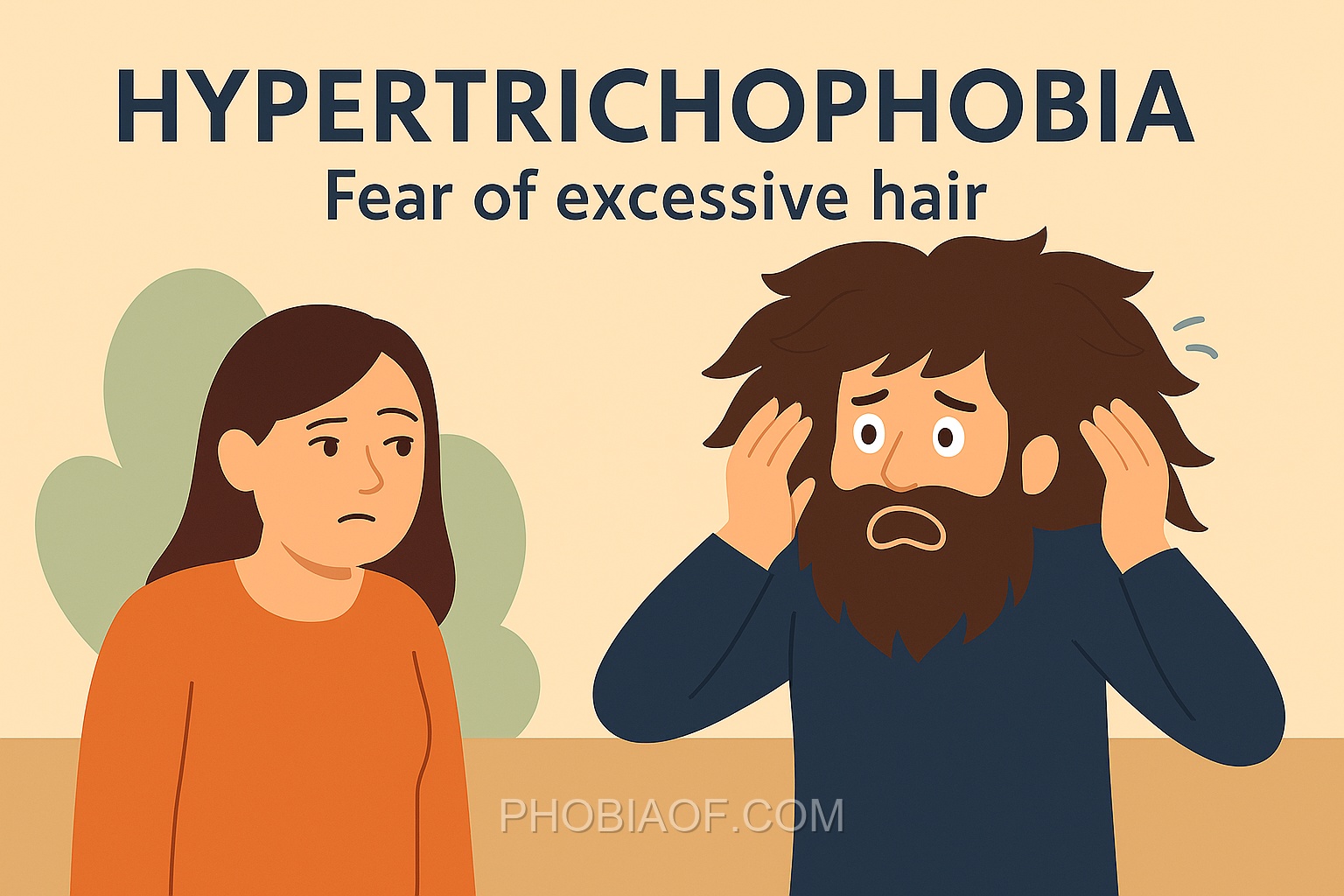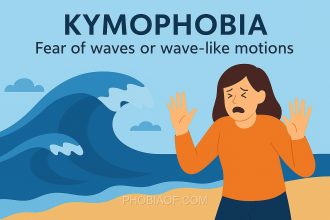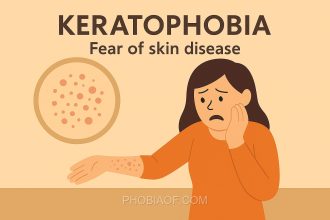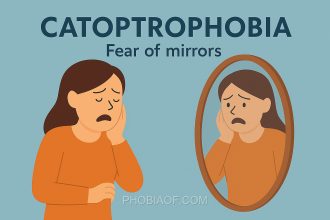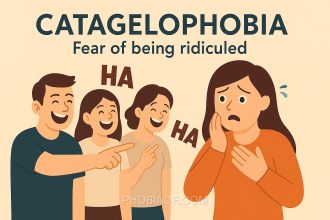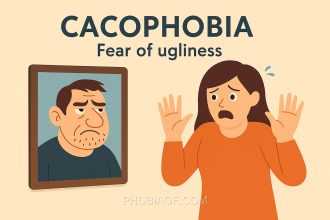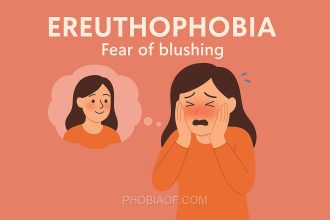Understanding Hypertrichophobia
Have you ever felt uneasy or anxious at the sight of excessive hair on yourself or others? If so, you might be experiencing what is known as Hypertrichophobia.
Hypertrichophobia is the fear of excessive hair. The term originates from the Greek words: “hyper,” meaning excessive, “tricho,” meaning hair, and “phobia,” meaning fear. This condition can cause significant distress for those who suffer from it, leading to avoidance behaviors and impacting their daily lives.
People with Hypertrichophobia may experience a range of symptoms, including anxiety, rapid heartbeat, or even panic attacks when encountering situations involving what they perceive as excessive hair. This fear can be triggered by seeing hair on one’s own body, on others, or even in certain visual media.
Generally, this phobia can affect individuals in various ways:
- Social Impact: Avoidance of social situations where they might encounter or discuss hair.
- Emotional Distress: Feelings of embarrassment or shame about their fear.
- Physical Symptoms: Experiencing stress-related symptoms, such as sweating or trembling.
Understanding and acknowledging this fear is the first step towards managing it. If you or someone you know is experiencing Hypertrichophobia, reaching out to a mental health professional can provide support and effective coping strategies.
Causes of Hypertrichophobia
Hypertrichophobia is the fear of excessive hair growth, which can be distressing for those who experience it. Understanding its causes can help in addressing the phobia effectively. Below are some potential causes:
- Genetic Predisposition:
Some individuals may have a genetic tendency to develop phobias, including hypertrichophobia. This predisposition can be influenced by family history, where anxiety disorders or specific phobias are present in relatives.
- Traumatic Experiences:
Experiencing or witnessing a traumatic event involving hair can trigger hypertrichophobia. For instance, a distressing situation involving excessive hair growth or even hair removal processes can lead to the development of this fear.
- Learned Behavior:
Observing others with a fear of hair or excessive hairiness can contribute to the development of hypertrichophobia. If significant figures in a person’s life express fear or disgust towards hair, this behavior might be learned and internalized.
- Psychological Factors:
Underlying anxiety disorders or other mental health issues can enhance susceptibility to phobias. Individuals with heightened anxiety might be more prone to developing specific fears, including that of excessive hair growth.
- Environmental Influences:
Cultural and societal norms about hair can also play a role. Societies that emphasize certain beauty standards may exacerbate concerns about hair, potentially leading to phobic reactions.
Interestingly, some theories suggest that phobias like hypertrichophobia may have evolutionary roots. The fear of excessive hair could be linked to survival instincts, where unusual appearances might signal health issues. While research is ongoing, understanding these factors can be crucial in developing effective treatments for those affected by this phobia.
Symptoms of Hypertrichophobia
Hypertrichophobia, an intense fear or anxiety related to excessive hair growth, can significantly impact a person’s emotional and physical well-being. Recognizing the symptoms is the first step towards understanding and addressing this phobia. Here are some common symptoms and manifestations:
- Intense Fear or Anxiety: Individuals experience an overwhelming sense of fear or anxiety when thinking about or encountering situations involving excessive hair growth.
- Panic Attacks: Sudden onset of fear characterized by chest pain, dizziness, shortness of breath, or feelings of losing control.
- Sweating: Noticeable sweating, especially in the presence of or when thinking about the feared situation.
- Rapid Heartbeat: An accelerated heartbeat when confronted with thoughts or images of excessive hair.
- Avoidance of Triggers: Actively avoiding situations, people, or places that might trigger the phobia.
- Overwhelming Dread: Persistent feelings of dread or impending doom related to excessive hair growth.
- Nausea or Stomach Upset: Experiencing gastrointestinal distress when faced with the phobic trigger.
- Emotional Distress: Heightened emotional responses, such as crying or feeling overwhelmed, when thinking about or seeing excessive hair.
If the phobia is severe, these symptoms can interfere with daily life, making it challenging to engage in normal activities, maintain relationships, or perform effectively at work or school.
Treatment for Fear of Excessive Hair (Hypertrichophobia)
Overcoming hypertrichophobia, the fear of excessive hair, is entirely possible with the right treatment and coping strategies. It’s important to understand that this phobia can be treated and managed over time, enabling you to lead a more comfortable and fulfilling life. Below, we outline several effective treatment options and self-help techniques that can support your journey towards overcoming this fear.
Proven Therapies
There are several therapeutic approaches that have proven effective in treating hypertrichophobia:
- Exposure Therapy: This therapy involves gradually facing the fear of excessive hair in a controlled and safe environment. By slowly exposing oneself to situations involving hair, the fear response can diminish over time.
- Cognitive-Behavioral Therapy (CBT): CBT focuses on changing the fearful thoughts and beliefs associated with hair. By identifying and altering negative thought patterns, individuals can reduce their anxiety and improve their response to fear-inducing situations.
- Counseling: Speaking with a counselor can provide a supportive space to explore the roots of the phobia and develop coping strategies. Counseling can also help in building resilience and understanding personal triggers.
Self-Help Coping Techniques
In addition to professional therapy, several self-help techniques can complement treatment and offer relief:
- Relaxation Exercises: Techniques such as deep breathing, progressive muscle relaxation, and visualization can help manage anxiety symptoms associated with hypertrichophobia.
- Meditation: Regular meditation practice can enhance mindfulness and reduce stress levels, aiding in the management of phobic reactions.
- Support Groups: Joining a support group can provide a sense of community and shared understanding. It can be comforting to connect with others who are experiencing similar challenges.
Medication
In severe cases of hypertrichophobia, medication such as anti-anxiety medications may be prescribed. However, it’s important to focus on therapy and coping skills as the primary treatment methods. Medication should be used under the guidance of a healthcare professional.
Remember, seeking professional help is a key step if hypertrichophobia is interfering with your daily life. A mental health professional can tailor a treatment plan specific to your needs, helping you overcome this fear effectively. Embrace the journey towards recovery with patience and self-compassion. You are not alone, and with time and effort, this phobia can be managed successfully.
Conclusion
Understanding the causes and symptoms of hypertrichophobia, the fear of excessive hair, is a crucial step towards empowerment and effective management of this phobia. By recognizing the underlying triggers and how they manifest, individuals can begin to take meaningful actions towards overcoming their fears. Knowledge is indeed power, and with a clearer picture of what hypertrichophobia entails, you can approach it with greater confidence and clarity.
It’s important to remember that many people successfully manage or even overcome their phobias with time, patience, and appropriate support. If you find that your fear of excessive hair is impacting your daily life, consider reaching out to a mental health professional or talking to a doctor. Therapies such as cognitive-behavioral therapy (CBT) have been proven effective in treating phobias, and there is no shame in seeking help.
Remember, you are not alone in this journey, and with the right resources and support, a brighter, more fearless future is within reach. Take the first step towards healing today and embrace the possibility of living without fear.
